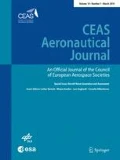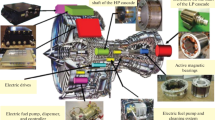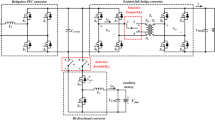Abstract
Hybrid electric and universally electric aircraft seem to be one possible option to fulfil ambitious future emission and noise reduction targets forced by the European Commission with the Strategic Research and Innovation Agenda and the NASA with the NASA N+3 goals. The overall vehicular efficiency of such concepts can be considerably improved. A key element is the design of the electric power train system with regard to efficiency and also mass. Based on a battery-powered direct current (DC) system architecture, the efficiency impact of different design voltages has been investigated in this paper. The main components within a DC electric architecture are power electronics such as converters and inverters, transmission cables, protection devices and cooling systems. Especially, the power electronics show the highest sensitivity when choosing a design system voltage. Two main losses occur within those components, conduction losses and switching losses. While conduction losses decrease with an increase in the design voltage, switching losses normally increase. Therefore, for a required design power there will be a trade-off between conduction and switching losses. For that purpose, two different architecture design philosophies were investigated to compare the system efficiencies at different design voltages. The first architecture is the constant system voltage (CSV) architecture, which compensates a decreasing output voltage of a battery, and a variable system voltage (VSV) architecture, which does not compensate this voltage drop. It has been identified that for an electric power train system delivering a constant power of 6000 kW, the VSV shows the best efficiency. The optimum system voltage of the VSV architecture is near the operating voltage of the electric motor, while the optimum system voltage of the CSV architecture was identified at higher voltages. These results will serve as baseline for the identification of the best voltage level for a mass- and efficiency-optimized system.



Adapted from [11]














Similar content being viewed by others
Abbreviations
- AC:
-
Alternating current
- CCM:
-
Continuous-current mode
- CHS:
-
Central heat sink
- CSV:
-
Constant system voltage
- DC:
-
Direct current
- ESR:
-
Equivalent series resistance
- IC:
-
Interstage cooler
- IGBT:
-
Insulated gate bipolar transistor
- HTS:
-
High-temperature superconducting
- LHS:
-
Local heat sink
- MOSFET:
-
Metal-oxide semiconductor field effect transistors
- PMSM:
-
Permanent magnet synchronous motor
- PWM:
-
Pulse width modulation
- SoA:
-
State of the art
- SOC:
-
State of charge
- SRIA:
-
Strategic research and innovation agenda
- SSPC:
-
Solid state power controller
- VSV:
-
Variable system voltage
References
Advisory Council for Aviation Research and Innovation in Europe: Strategic research and innovation agenda. vol. 1. Brussels (2012)
Bradley, M., Droney, C., Paisley, D., Roth, B.: NASA N+3 subsonic ultra green aircraft research SUGAR final review. In: Boeing Research and Technology (2010). Huntington Beach, CA
Pornet, C., Gologan, C., Vratny, P.C., Seitz, A., Schmitz, O., Isikveren, A.T., Hornung, M.: Methodology for Sizing and Performance Assessment of Hybrid Energy Aircraft. J. Aircr. (2014). doi:10.2514/1.C032716
Brown, G.V.: Weights and efficiencies of electric components of a turboelectric aircraft propulsion system. In 49th AIAA Aerospace Sciences Meeting including the New Horizons Forum and Aerospace Exposition (2011)
Stückl, S., van Toor, J., Lobentanzer, H.: VOLTAIR—the all electric propulsion concept platform—a vision for atmospheric friendly flight. In: 28th International Congress of the Aeronautical Sciences (2012)
Cotton, I., Nelms, A., Husband, M.: Higher voltage aircraft power systems. IEEE. A&E. Syst. Mag 23(2), 25–32 (2008). doi:10.1109/MAES.2008.4460728
Moir, I., Seabridge, A.: Aircraft systems: mechanical, electrical, and avionics subsystems integration, 3rd edn. Wiley, West Sussex (2008)
Isikveren, A.T., Seitz, A., Vratny, P.C., Pornet, C., Plötner, K.O., Hornung, M.: Conceptual studies of universally-electric systems architectures suitable for transport aircraft. In: Deutscher Luft-und Raumfahrt Kongress 2012, Berlin, Germany (2012)
Fossato, F.: Loss estimation in a voltage source inverter for electrical drives. University of Padua, Padua (2014)
Wintrich, A., Nicolai, U., Tursky, W., Reimann, T.: Application manual power semiconductors. ISLE Verlag, Ilmenau (2011)
Vratny, P.C., Forsbach, P., Seitz, A., Hornung, M.: Investigation of universally electric propulsion systems for transport aircraft. In: 29th international congress of the aeronautical sciences (2014)
SEMIKRON: SEMIKRON/SemiSel 4.1. [Online]. http://semisel.semikron.com/circuit.asp. Accessed 15 June 2015
Kouro, S., Malinowski, M., Gopakumar, K., Pou, J., Franquelo, L.G., Wu, B., Rodriguez, J., Pérez, M.A., Leon, J.I.: Recent advances and industrial applications of multilevel converters. IEEE Transact. Ind. Electron. 57(8), 2553–2580 (2010)
Ejury, J.: Buck converter design. Infineon Design Note DN 2013-01 (2013)
Schelle, D., Castorena, J.: Buck-converter design demystified. Power Electron. Technol. No. June, pp. 46–53 (2006)
Isikveren, A.T., Pornet, C., Vratny, P.C., Schmidt, M.: Conceptual studies of future hybrid-electric regional aircraft. In: ISABE 2015 (2015)
Sinnet, M.: 787 no-bleed systems: saving fuel and enhancing operational efficiency. Boeing Aeromagazin [Online]. http://www.boeing.com/commercial/aeromagazine/articles/qtr_4_07/AERO_Q407_article2.pdf (2007). Accessed 17 July 2011
Vratny, P.C., Gologan, C., Pornet, C., Isikveren, A.T., Hornung, M.: Battery pack modeling methods for universally-electric aircraft. In: CEAS 2013 (2013)
Seitz, A., Isikveren, A.T., Hornung, M.: Pre-concept performance investigation of electrically powered aero-propulsion system. In: 49th AIAA/ASME/SAE/ASEE Joint Propulsion Conference and Exhibit, San José (2013)
Mohapatra, S.C.: An overview of liquid coolants for electronics cooling. Electron. Cool. 12(2), 22–27 (2006)
Armstrong, M.: System level design considerations of a superconducting TeDP microgrid. In: IMechE Disruptive Green Propulsion Technologies Conference (2014)
Yole Developpement: Overview of wide band gap semiconductors in power electronics. Yole Developpement (2013)
Acknowledgments
The authors would like to thank P. Forsbach, U. Kling and S. Kaiser for valuable advice and fruitful discussions.
Author information
Authors and Affiliations
Corresponding author
Additional information
This paper is based on a presentation at the German Aerospace Congress, September 22–24, 2015, Rostock, Germany.
Rights and permissions
About this article
Cite this article
Vratny, P.C., Kuhn, H. & Hornung, M. Influences of voltage variations on electric power architectures for hybrid electric aircraft. CEAS Aeronaut J 8, 31–43 (2017). https://doi.org/10.1007/s13272-016-0218-z
Received:
Revised:
Accepted:
Published:
Issue Date:
DOI: https://doi.org/10.1007/s13272-016-0218-z




